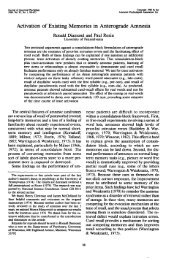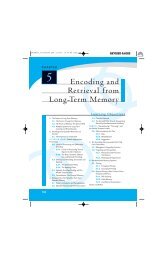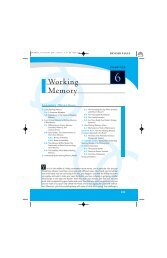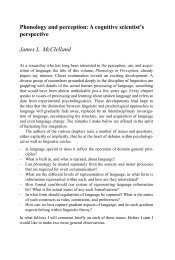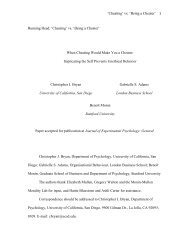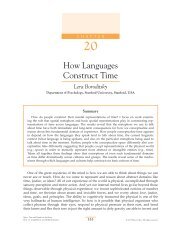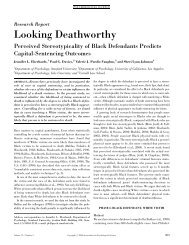Embodied and disembodied cognition: Spatial perspective-taking
Embodied and disembodied cognition: Spatial perspective-taking
Embodied and disembodied cognition: Spatial perspective-taking
Create successful ePaper yourself
Turn your PDF publications into a flip-book with our unique Google optimized e-Paper software.
likely to improve action underst<strong>and</strong>ing, but does not seem<br />
relevant to underst<strong>and</strong>ing attitudes or emotions.<br />
Collectively, the present findings show that the mere<br />
presence of another person in a scene changes the way<br />
people think about the spatial relations among objects in<br />
the scene. Although not all participants took the <strong>perspective</strong><br />
of the person in the scene instead of their own <strong>perspective</strong>,<br />
a majority did when the question focused<br />
attention on action. Given that there were no dem<strong>and</strong>s, explicit<br />
or implicit, to take the other’s <strong>perspective</strong>, this result<br />
discounts claims that an egocentric <strong>perspective</strong> is primary<br />
<strong>and</strong> natural (e.g., Eppley, Morewedge, & Keysar, 2004; Hart<br />
& Moore, 1973; Levelt, 1989; Piaget & Inhelder, 1956). On<br />
the contrary, in some situations, <strong>taking</strong> the other’s <strong>perspective</strong><br />
appears to be more natural <strong>and</strong> spontaneous than<br />
<strong>taking</strong> one’s own.<br />
Much has been said about embodied <strong>cognition</strong> (e.g.,<br />
Barsalou, Niedenthal, Barbey, & Ruppert, 2003; Borghi,<br />
Glenberg, & Kaschak, 2004). The present results show that<br />
the deep meaning of embodied <strong>cognition</strong> is that it enables<br />
<strong>disembodied</strong> thought (e.g., Tversky, 2005). Here, people<br />
overcame their own embodied position in space to take<br />
an imaginary one, they escaped the entrapment of minds<br />
in bodies <strong>and</strong> bodies in views on space through imagination.<br />
What’s surprising <strong>and</strong> significant is that people spontaneously<br />
take other <strong>perspective</strong>s despite the very real<br />
presence of their own.<br />
Acknowledgment<br />
This research was partially supported by a National Research<br />
Service Award from the National Institute of Health<br />
to Bridgette Martin Hard.<br />
References<br />
Barsalou, L. W., Niedenthal, P. M., Barbey, A. K., & Ruppert, J. A. (2003).<br />
Social embodiment. In B. H. Ross (Ed.), The psychology of learning <strong>and</strong><br />
motivation (pp. 43–92). San Diego: Academic Press.<br />
Borghi, A. M., Glenberg, A. M., & Kaschak, M. P. (2004). Putting words in<br />
<strong>perspective</strong>. Memory <strong>and</strong> Cognition, 32, 863–873.<br />
Bryant, D. J., Tversky, B., & Franklin, N. (1992). Internal <strong>and</strong> external<br />
spatial frameworks for representing described scenes. Journal of<br />
Memory <strong>and</strong> Language, 31, 74–98.<br />
Eppley, N., Morewedge, C. K., & Keysar, B. (2004). Journal of Experimental<br />
Social Psychology, 40, 760–768.<br />
Author's personal copy<br />
B. Tversky, B.M. Hard / Cognition 110 (2009) 124–129 129<br />
Franklin, N., & Tversky, B. (1990). Searching imagined environments.<br />
Journal of Experimental Psychology: General, 119, 63–76.<br />
Gallese, V., Keysers, C., & Rizzolatti, G. (2004). A unifying view of the basis<br />
of social <strong>cognition</strong>. Trends in Cognitive Sciences, 8, 396–403.<br />
Golledge, R. G. (1992). Place re<strong>cognition</strong> <strong>and</strong> wayfinding: Making sense of<br />
space. Geoforum, 23, 199–214.<br />
Graziano, M. S. A., & Gross, C. G. (1994). Mapping space with neurons.<br />
Current Directions in Psychological Science, 3, 164–167.<br />
Hart, R. A., & Moore, G. T. (1973). The development of spatial <strong>cognition</strong>. In<br />
R. M. Downs & D. Stea (Eds.), Image <strong>and</strong> environment (pp. 246–288).<br />
Chicago: Aldine.<br />
Jackson, P. L., Meltzoff, A. N., & Decety, J. (2006). Neural circuits involved<br />
in imitation <strong>and</strong> <strong>perspective</strong>-<strong>taking</strong>. NeuroImage, 31, 429–439.<br />
Lamm, C., Batson, C. D., & Decety, J. (2007). The neural substrate of<br />
human empathy – Effects of <strong>perspective</strong>-<strong>taking</strong> <strong>and</strong> cognitive<br />
appraisal: An event-related fMRI study. Journal of Cognitive<br />
Neuroscience, 19, 42–58.<br />
Levelt, W. J. M. (1989). Speaking: From intention to articulation. Cambridge:<br />
MIT Press.<br />
Levinson, S. (1996). Frames of reference <strong>and</strong> Molyneux’s question: Crosslinguistic<br />
evidence. In P. Bloom, M. A. Peterson, L. Nadel, & M. F.<br />
Garrett (Eds.), Space <strong>and</strong> Language (pp. 109–169). Cambridge: MIT<br />
Press.<br />
Mainwaring, S. D., Tversky, B., Ohgishi, M., & Schiano, D. J. (2003).<br />
Descriptions of simple spatial scenes in English <strong>and</strong> Japanese. <strong>Spatial</strong><br />
Cognition <strong>and</strong> Computation, 3, 3–42.<br />
Mou, W., McNamara, T. P., Valiquette, C. M., & Rump, B. (2004). Allocentric<br />
<strong>and</strong> egocentric updating of spatial memory. Journal of Experimental<br />
Psychology: Learning Memory <strong>and</strong> Cognition, 30, 142–157.<br />
O’Keefe, J., & Nadel, L. (1978). The hippocampus as a cognitive map. New<br />
York: Oxford University Press.<br />
Piaget, J., & Inhelder, B. (1956). The child’s conception of space. London:<br />
Routledge <strong>and</strong> Kegan Paul.<br />
Pick, H. L., Jr., & Lockman, J. J. (1981). From frames of reference to spatial<br />
representations. In L. S. Liben, A. H. Patterson, & N. Newcombe (Eds.),<br />
<strong>Spatial</strong> representation <strong>and</strong> behavior across the life span: Theory <strong>and</strong><br />
application (pp. 39–60). New York: Academic Press.<br />
Rizzonlatti, G., Fadiga, L., Gallese, V., & Fogassi, L. (1995). Premotor cortex<br />
<strong>and</strong> the re<strong>cognition</strong> of motor actions. Cognitive Brain Research, 3,<br />
131–141.<br />
Schober, M. F. (1993). <strong>Spatial</strong> <strong>perspective</strong>-<strong>taking</strong> in conversation.<br />
Cognition, 47, 1–24.<br />
Schober, M. F. (1995). Speakers, addressees, <strong>and</strong> frames of reference.<br />
Whose effort is minimized in conversations about locations?<br />
Discourse Processes, 20, 219–247.<br />
Shelton, A. L., & McNamara, T. P. (1997). Multiple views of spatial<br />
memory. Psychonomic Bulletin <strong>and</strong> Review, 4, 102–106.<br />
Taylor, H. A., & Tversky, B. (1996). Perspective in spatial descriptions.<br />
Journal of Memory <strong>and</strong> Language, 35, 371–391.<br />
Tipper, S. P., & Behrmann, M. (1996). Object-centered not scene-based<br />
visual neglect. Journal of Experimental Psychology: Human Perception<br />
<strong>and</strong> Performance, 22, 1261–1278.<br />
Tversky, B. (2005). <strong>Embodied</strong> <strong>and</strong> <strong>disembodied</strong> <strong>cognition</strong>. In A. Berthoz &<br />
R. Recht (Eds.), Les Espaces de l’Homme (pp. 161–184). Paris: Odile<br />
Jacob.<br />
Tversky, B., Lee, P. U., & Mainwaring, S. (1999). Why speakers mix<br />
<strong>perspective</strong>s. Journal of <strong>Spatial</strong> Cognition <strong>and</strong> Computation, 1, 399–412.



